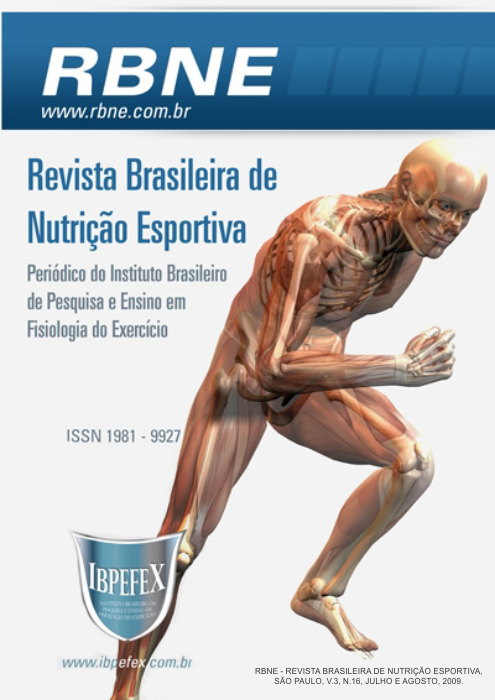Correlation of the lactate threshold and threshold glycemic in exercises of located muscular resistance with supplementation of maltodextrina in different percentages
Abstract
The objective of this study was to verify the ergogenic effect of the supplementation with different concentrations of maltodextrina (6%, 12% and 18%) and placebo in the training of located muscular resistance. Moreover, to correlate sanguineous lactate with the circulating glucose. For in such a way, 7 individuals of the masculine sex had been selected, physically active. The participants had been submitted the four previous exercises (supine rectum, squat, pulley coasts and flexor table), measured 1RM and repetitions until the imperfection mechanics with 50, 60 and 70% of 1RM. Serving to find the adequate load 50% of 1RM in the biggest muscular groupings. The training was composed for fifteen exercises, “alternated for pursuing” with only one series until the imperfection mechanics with 50% of 1RM, interval of ninth seconds between series. To each five exercises were collected: Lactate, glycemia, two tests has controlled (test of supine in one minute and horizontal jump) and the supplementation (150ml), which was divided at four moments (600 ml) for session of trainings. Conclusion, the carbohydrate ingestion was capable to attenuate the deleterious effect of the training of located muscular resistance in the tests has controlled, supine in one minute, with 18% of carbohydrate 33.67, while with placebo 29.60 results in (average and shunting line standard), horizontal jump, carbohydrate 12% 192.92, placebo 184.58, now with carbohydrate 18% 180.83, being the lesser measured distance. It is necessary that it is carried through more invasive studies correlating such facts.
References
- Dantas, E.H.M. A Prática da Preparação Física 5ª ed. Rio de Janeiro. Shape, 2003. p. 345 - 358.
- Maughan, R.J.; Burke, L.M. Nutrição esportiva. 1a ed. Porto Alegre. Artmed. 2004.
- McArdle, W.D.; Katch, F.I.; Katch, V.L. Fisiologia do Exercício: Energia, Nutrição e Desempenho Humano. 5a ed. Rio de Janeiro. Guanabara Koogan. 2003.
- Pereira, B.; Souza Junior, T. P. Metabolismo Celular e Exercício Físico: Aspectos Bioquímicos e Nutricionais. 2ª ed. São Paulo. Phorte. 2007. p. 113-128.
- Sapata, K.B.; Fayh, A.P.T.; Oliveira, A.R. Efeito do Consumo Prévio de Carboidrato Sobre a Resposta Glicêmica e Desempenho Sobre a Resposta Glicêmica e Desempenho. Revista Brasileira de Medicina do Esporte. Niterói. Vol. 12. Num. 4. Ago 2006. p. 189-194.
- Uchida, M.C.; Charro, M.A.; Bacurau, R.F.P.; Navarro, F.; Pontes Junior, F.L. Manual da Musculação: Uma Abordagem Teórico-Prática do Treinamento de Força. 3ª ed. São Paulo. Phorte. 2005. p. 185-192.
- Wilmore. J.H.; Costill. D.L. Fisiologia do Esporte e do Exercício. 2ª ed. São Paulo. Manole. 2001. p. 451-487.
- Wolinsky, I.; Hickson Junior, J.F. Nutrição no Exercício e no Esporte. 2ª ed. São Paulo. Roca. 2002. p. 19-59.
Authors who publish in this journal agree to the following terms:
- Authors retain the copyright and grant the journal the right of first publication, with work simultaneously licensed under the Creative Commons Attribution License BY-NC which allows the sharing of the work with acknowledgment of the authorship of the work and initial publication in this journal.
- Authors are authorized to enter into additional contracts separately for non-exclusive distribution of the version of the work published in this journal (eg, publishing in institutional repository or book chapter), with acknowledgment of authorship and initial publication in this journal.
- Authors are allowed and encouraged to post and distribute their work online (eg, in institutional repositories or on their personal page) at any point before or during the editorial process, as this can bring about productive change as well as increase impact and impact. citation of published work (See The Effect of Free Access).






